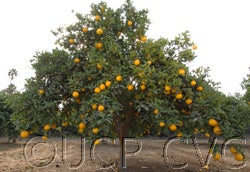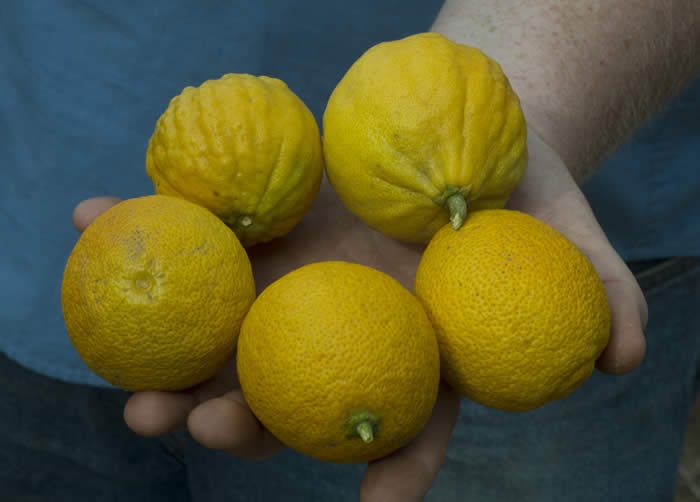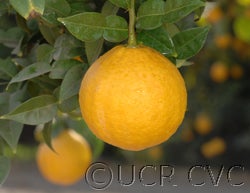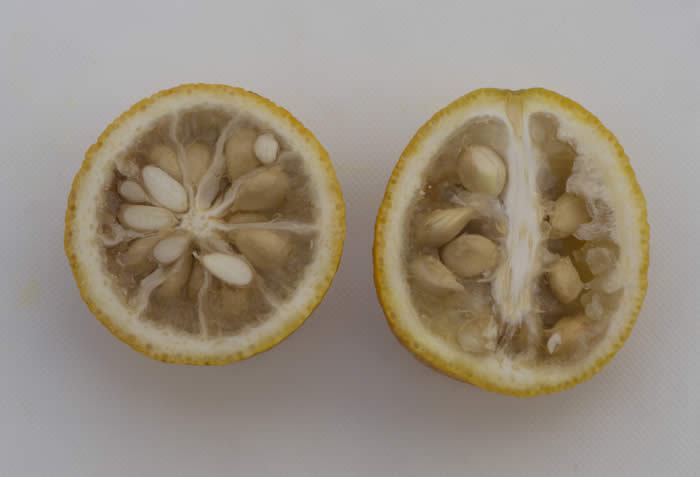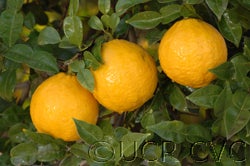Citrus ichangensis
CRC 3931
PI 539253
Source
Received as seed and grown by R.K. Soost, 1985.
Parentage/origins
Parents unknown. From China.
Rootstocks of accession
Yuma Ponderosa lemon.
Season of ripeness at Riverside
Unknown at this time.
Notes and observations
11/13/1989, EMN:First fruit here, good crop. Larger & seedier fruit than other C. ichang accessions. Seems to be true C. ichangensis.
11/29/2007, DK & TS: Round orange fruit, unlike the other selections in the CVC. Fruit is seedy and bland.
Description from The Citrus Industry Vol. 1 (1967)
"Citrus ichangensis Swing.
Type.—China, Hupeh Province, Hsing shan district (E. H. Wilson). Herb. Arnold Arbor., Harv. Univ., Cambridge.
Distribution.—West-central and southwestern China: Hupeh, Szechwan, Kweichow, and Yunnan provinces.
Common name.—Ichang papeda.
A spiny shrub or small tree usually 5-15 ft. [1.5-4.6 m] high; twigs angular when young, with stout, sharp spines, 1.5-2.5 cm long, often reduced or lacking on flowering twigs; leaves narrow, 4-6 times longer than wide, mostly 8-11.5 X 1.8-3 cm; petioles very large, broadly winged, obovate or oblong-spatulate, evenly rounded at the tip and narrowed abruptly at the base, usually 3.5-6 X 2-3 cm; leaf blade ovate-acuminate, often more or less caudate, emarginate at the tip and evenly rounded or bluntly pointed at the base, usually 3-6 X 1.8-3 cm, often not equaling the winged petiole in area; flowers 2.5-3 cm diam., 5-merous; sepals thick, 3 mm long and 3 mm wide, with minutely ciliate margins; petals oblong, 1.5-2 X 0.5-0.8 cm, white; stamens 20, at first all connate to the tips, finally breaking up into several bundles, about 10 mm long; pistil about 10 mm long; style very short, caducous; stigma nearly as large as the ovary; ovary with 7-9 locules, ovules numerous in each locule; fruits small, glabrous, 3-4 cm diam. in dried specimens (probably 3.5-5 cm when fresh), peel rough, 2-4 mm thick in dried specimens; seeds large, very thick, 12-18 X 12-18 X 7-9 mm in dried material, very blunt at both ends, with a chalazal cap about 12 X 5 mm, apparently monoembryonic.
This species differs from its congeners in having large, very thick seeds and slender leaves 4-6 times longer than broad, with very large, winged petioles often as large or larger than the blade. It differs from C. hystrix in having oblong, rather than triangular, winged petioles and much larger flowers with connate stamens.
This remarkable plant, which grows in a truly wild state in central and southwestern China, is doubtless the most cold-resistant of all the evergreen species in the orange subfamily. It differs greatly from the other species in the subgenus Papeda in having large flowers, partly connate stamens, and large, very thick seeds, which are nevertheless monoembryonic. The leaves also differ from those of all other species of Papeda in having extremely long but rather narrow winged petioles, often exceeding in area the slender, pointed, lanceolate leaf blades.
In 1926, Swingle brought to this country a healthy young seedling of this plant from Hupeh Province, grown for him at Nanking, China, by C. C. Hu. As C. ichangensis is the hardiest known evergreen species of Citrus, it is of great interest for use in breeding cold-resistant hybrids, such as the Ichang lemon and Yuzu."
Availability
Not commercially available in California.
USDA Germplasm Resources Information Network page for Ichang papeda (CRC 3931)
